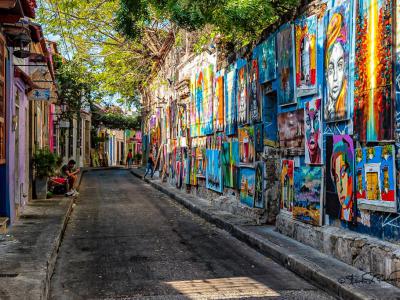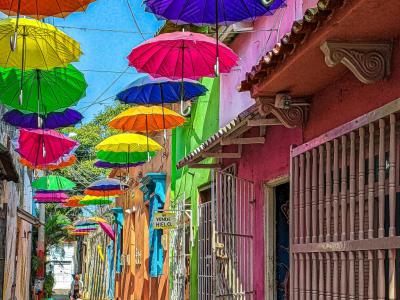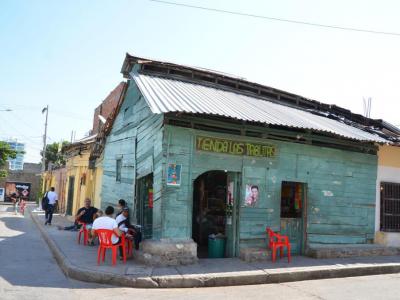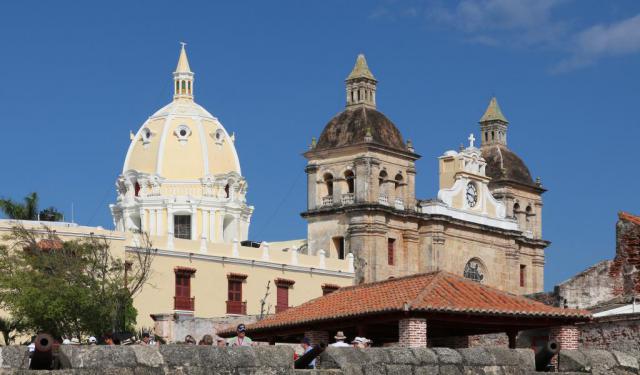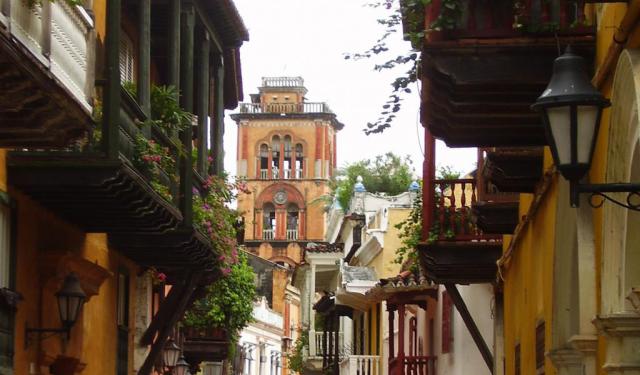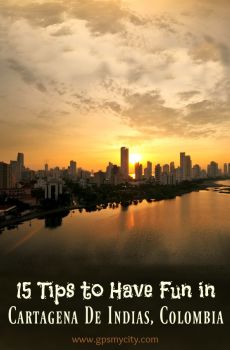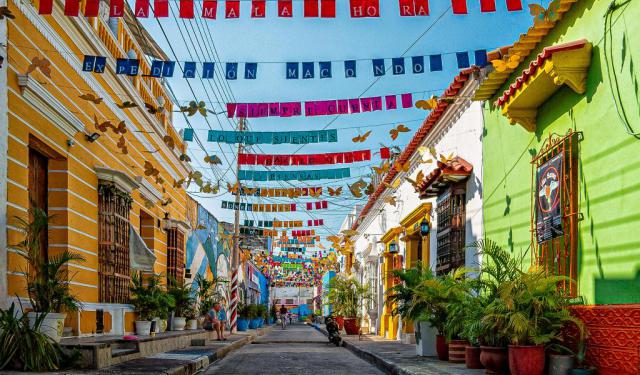
Getsemani Public Arts Walking Tour (Self Guided), Cartagena
Long known as the "neighborhood of the poor" ill-reputed for criminal activity, the district of Getsemani has recently undergone massive gentrification to become Cartagena's hippest area and one of Latin America's newest hotspots. The local plazas, once occupied by drug dealers, have been reclaimed, and the derelict buildings turned into boutique hotels.
But most importantly, the enormous Cultural Renaissance of the early 2010s saw the district, historically inhabited by servants and low-class workers, turn into a magnet for artists and creative folk from around the world, prompting many a visitor to shift their attention here as a more affordable and authentic alternative to Downtown Cartagena.
One of the most striking (and obvious) attributes of this rebirth is the Getsemani graffiti, the mesmerizing array of colorful murals created by local and international artists, seen almost everywhere. Most of them depict life scenes such as street vendors and children playing, iconic figures like Nobel laureate Gabriel García Márquez and national hero Pedro Romero, or even abstract paintings.
Among the most frequented locations – included in the obligatory walking trail for tourists – is the "serpent-like" Calle de la Sierpe (Serpent Street), the epicenter of wall art in the city. The curvy alley of Calle de San Juan (St. John's Street), connected to La Sierpe, is also easy to spot as a tempting option to socialize in its cozy eateries amid the artistic beauty adorning the walls.
Another colorful destination not to miss is Calle de las Chancletas (Flip Flops Street); here, the vivid colors on the facades are richly complemented by the natural beauty: the jungle gardens and vines sprouting from the walls, combined with the intense sunlight. Calle de las Sombrillas (Umbrellas Street), formerly known as Callejón Angosto (Narrow Alley), is a picture-perfect location overhung with colorful umbrellas that light up at night.
No trip to Cartagena would be complete without visiting Getsemaní, the artistic heart and soul of the city. But even if murals are not the reason enough to come here, there is always something else to discover. The streets of Getsemaní speak of the history of Colombia. They exude magic, life and charm, and are good for touring any time of day, especially if you're self-guided by the GPSmyCity app!
But most importantly, the enormous Cultural Renaissance of the early 2010s saw the district, historically inhabited by servants and low-class workers, turn into a magnet for artists and creative folk from around the world, prompting many a visitor to shift their attention here as a more affordable and authentic alternative to Downtown Cartagena.
One of the most striking (and obvious) attributes of this rebirth is the Getsemani graffiti, the mesmerizing array of colorful murals created by local and international artists, seen almost everywhere. Most of them depict life scenes such as street vendors and children playing, iconic figures like Nobel laureate Gabriel García Márquez and national hero Pedro Romero, or even abstract paintings.
Among the most frequented locations – included in the obligatory walking trail for tourists – is the "serpent-like" Calle de la Sierpe (Serpent Street), the epicenter of wall art in the city. The curvy alley of Calle de San Juan (St. John's Street), connected to La Sierpe, is also easy to spot as a tempting option to socialize in its cozy eateries amid the artistic beauty adorning the walls.
Another colorful destination not to miss is Calle de las Chancletas (Flip Flops Street); here, the vivid colors on the facades are richly complemented by the natural beauty: the jungle gardens and vines sprouting from the walls, combined with the intense sunlight. Calle de las Sombrillas (Umbrellas Street), formerly known as Callejón Angosto (Narrow Alley), is a picture-perfect location overhung with colorful umbrellas that light up at night.
No trip to Cartagena would be complete without visiting Getsemaní, the artistic heart and soul of the city. But even if murals are not the reason enough to come here, there is always something else to discover. The streets of Getsemaní speak of the history of Colombia. They exude magic, life and charm, and are good for touring any time of day, especially if you're self-guided by the GPSmyCity app!
How it works: Download the app "GPSmyCity: Walks in 1K+ Cities" from Apple App Store or Google Play Store to your mobile phone or tablet. The app turns your mobile device into a personal tour guide and its built-in GPS navigation functions guide you from one tour stop to next. The app works offline, so no data plan is needed when traveling abroad.
Getsemani Public Arts Walking Tour Map
Guide Name: Getsemani Public Arts Walking Tour
Guide Location: Colombia » Cartagena (See other walking tours in Cartagena)
Guide Type: Self-guided Walking Tour (Sightseeing)
# of Attractions: 6
Tour Duration: 1 Hour(s)
Travel Distance: 0.8 Km or 0.5 Miles
Author: nataly
Sight(s) Featured in This Guide:
Guide Location: Colombia » Cartagena (See other walking tours in Cartagena)
Guide Type: Self-guided Walking Tour (Sightseeing)
# of Attractions: 6
Tour Duration: 1 Hour(s)
Travel Distance: 0.8 Km or 0.5 Miles
Author: nataly
Sight(s) Featured in This Guide:
- Calle de la Sierpe (Serpent Street)
- Calle de San Juan (San Juan Street)
- Plaza de La Trinidad (Trinity Square)
- Callejón Angosto (Narrow Alley)/Calle de las Sombrillas (Umbrella Street)
- Calle de las Chancletas (Flip Flops Street)
- Calle e Plazuela del Pozo (Well Street and Square)
1) Calle de la Sierpe (Serpent Street)
The first thing you notice on Calle de la Sierpe (Serpent Street) is the bright colors on the walls and the flags hanging over your head as you walk. Looping around from Calle Media Luna to the emblematic Plaza de la Trinidad (a place where important historical events once took place, determining the independence of Cartagena and consequently that of Colombia), this street – also known as Calle 29 – has a great deal of historical importance attached to it. However, it is the abundance of urban art illustrating the legends and mysteries surrounding Calle de la Sierpe's past that makes it one of the most popular destinations in the city.
Indeed, the ubiquitous graffiti here is the main attraction; found practically everywhere – on the walls, doors, and windows, and sometimes even on ruined buildings, – they effectively turn the area into one big photo op.
Standing out among them, in particular, are the two artworks: the Grinning Afro-Colombian Woman, and La Sierpe. The former – a large, striking mural by Dexs – is one of the most photographed pieces of street art in Cartagena. As for the latter (La Sierpe), this depiction of a half-woman, half-snake refers to a legend that gave the street its name.
Back in 1608, locals were often bothered by a hissing sound at night that came from what seemed like a big creature crawling on the ground, making a rattling noise. Gripped by fear, the people complained to the city mayor, Don Antonio de Viloria, who bravely ventured out several nights to find out the cause of it. One night, he finally managed to unveil the mystery – a giant rattlesnake! The serpent appeared out of nowhere, with its menacing phosphorescent eyes, wriggling and noisily shaking the large rattles on its tail.
The mayor, armed with courage and the magic technique he had learned on the island of Santa Domingo, drew some magical figures in the air, immediately after which the snake started to writhe and transformed into a woman, who happened to be a witch. The sorceress begged for forgiveness and implored clemency. According to the legend, she was imprisoned until 1614 when the Holy Inquisition Court sentenced her to 200 lashes and final banishment – for heresy.
As you venture further down the street, keep your eyes peeled for the depictions of indigenous people, as well as some other images, to get a sense of the fascinating ethnic diversity of the local population.
Indeed, the ubiquitous graffiti here is the main attraction; found practically everywhere – on the walls, doors, and windows, and sometimes even on ruined buildings, – they effectively turn the area into one big photo op.
Standing out among them, in particular, are the two artworks: the Grinning Afro-Colombian Woman, and La Sierpe. The former – a large, striking mural by Dexs – is one of the most photographed pieces of street art in Cartagena. As for the latter (La Sierpe), this depiction of a half-woman, half-snake refers to a legend that gave the street its name.
Back in 1608, locals were often bothered by a hissing sound at night that came from what seemed like a big creature crawling on the ground, making a rattling noise. Gripped by fear, the people complained to the city mayor, Don Antonio de Viloria, who bravely ventured out several nights to find out the cause of it. One night, he finally managed to unveil the mystery – a giant rattlesnake! The serpent appeared out of nowhere, with its menacing phosphorescent eyes, wriggling and noisily shaking the large rattles on its tail.
The mayor, armed with courage and the magic technique he had learned on the island of Santa Domingo, drew some magical figures in the air, immediately after which the snake started to writhe and transformed into a woman, who happened to be a witch. The sorceress begged for forgiveness and implored clemency. According to the legend, she was imprisoned until 1614 when the Holy Inquisition Court sentenced her to 200 lashes and final banishment – for heresy.
As you venture further down the street, keep your eyes peeled for the depictions of indigenous people, as well as some other images, to get a sense of the fascinating ethnic diversity of the local population.
2) Calle de San Juan (San Juan Street)
Stemming from Calle de la Sierpe to the south is a curved, narrow alley – Calle de San Juan (San Juan Street). Named after Saint John the Baptist, this is one of the few places in Cartagena to retain its original name from colonial times.
At 187 meters, this is also one of the longest “inner” streets in the Getsemaní neighborhood, and with a great deal of history packed inside these 187 meters, too. A century ago, this street was famed as the one inhabited by Admiral José Prudencio Padilla, the hero of the Expulsion of Mexico’s Spaniards in 1821-1836. More recently, it was the home of the notorious gangster, Samir Beetar, who made the name for himself among locals by helping needy neighbors and those with sick children pay for their medicine.
Still, what makes Calle de San Juan stand out today, at least in the eyes of numerous visitors, is the impressive collection of wall paintings coupled with an array of delightful cafes and restaurants lining the street. While the eateries and drinking establishments lure passers-by with their cozy atmosphere, the color palette of the surrounding artwork makes one feel as if drifting down the river of ink... Both pastimes are equally engaging!
At 187 meters, this is also one of the longest “inner” streets in the Getsemaní neighborhood, and with a great deal of history packed inside these 187 meters, too. A century ago, this street was famed as the one inhabited by Admiral José Prudencio Padilla, the hero of the Expulsion of Mexico’s Spaniards in 1821-1836. More recently, it was the home of the notorious gangster, Samir Beetar, who made the name for himself among locals by helping needy neighbors and those with sick children pay for their medicine.
Still, what makes Calle de San Juan stand out today, at least in the eyes of numerous visitors, is the impressive collection of wall paintings coupled with an array of delightful cafes and restaurants lining the street. While the eateries and drinking establishments lure passers-by with their cozy atmosphere, the color palette of the surrounding artwork makes one feel as if drifting down the river of ink... Both pastimes are equally engaging!
3) Plaza de La Trinidad (Trinity Square)
Plaza de la Trinidad in Cartagena's Getsemaní takes its name from the eponymous church, La Iglesia de la Santísima Trinidad, located right in front of it, completed in 1643.
The square is historically significant as the place of the country's first independence movement, the rebellion of Gethsemane lancers, in 1811, headed by blacksmith Pedro Romero. It ultimately led to the declaration of independence of what was then known as the city of Cartagena de Indias from the Spanish crown, some 11 years before the rest of the country became independent. Following the event, the square was renamed Plaza de la Libertad (Freedom Square).
Today, there is a sculpture in the plaza paying tribute to Pedro Romero. Created by artist Nora Quintana, the sculptural group (made of fiberglass, resin and bronze patina) features Romero with his fist raised high in the air, accompanied by the Franciscan priest Father Umaña, and a Drummer.
Lately, the bohemian air of Getsemaní neighborhood found its way to this area in the form of graffiti. Alluding to the life and customs of the city, the graffiti create the image of a colonial-era plaza “disguised as a modern spot”, all the more beautiful in its own rustic way.
A piece of wall art to be noted in particular here is the picture-perfect mural of a black bird called Maria Mulata, which is the official bird of Cartagena. Painted by Colombian artist and graphic designer, Yurika MDC, at a glance, it seems just like an ordinary bird painted on yellow background, with some flashing lights of different colors added for decoration. However, locals know that, when the sun hits the bird from certain angles, these bright colors come to a full, meaningful display. Reportedly, the artist borrowed the idea for the mural from an old story told by a longtime Getsemaní resident.
Attractive by day, the square is also one of the coolest hangouts at night thanks to the street performers, food stands, and dine-in restaurants located nearby, largely stimulating the attendance by tourists and locals alike.
The square is historically significant as the place of the country's first independence movement, the rebellion of Gethsemane lancers, in 1811, headed by blacksmith Pedro Romero. It ultimately led to the declaration of independence of what was then known as the city of Cartagena de Indias from the Spanish crown, some 11 years before the rest of the country became independent. Following the event, the square was renamed Plaza de la Libertad (Freedom Square).
Today, there is a sculpture in the plaza paying tribute to Pedro Romero. Created by artist Nora Quintana, the sculptural group (made of fiberglass, resin and bronze patina) features Romero with his fist raised high in the air, accompanied by the Franciscan priest Father Umaña, and a Drummer.
Lately, the bohemian air of Getsemaní neighborhood found its way to this area in the form of graffiti. Alluding to the life and customs of the city, the graffiti create the image of a colonial-era plaza “disguised as a modern spot”, all the more beautiful in its own rustic way.
A piece of wall art to be noted in particular here is the picture-perfect mural of a black bird called Maria Mulata, which is the official bird of Cartagena. Painted by Colombian artist and graphic designer, Yurika MDC, at a glance, it seems just like an ordinary bird painted on yellow background, with some flashing lights of different colors added for decoration. However, locals know that, when the sun hits the bird from certain angles, these bright colors come to a full, meaningful display. Reportedly, the artist borrowed the idea for the mural from an old story told by a longtime Getsemaní resident.
Attractive by day, the square is also one of the coolest hangouts at night thanks to the street performers, food stands, and dine-in restaurants located nearby, largely stimulating the attendance by tourists and locals alike.
4) Callejón Angosto (Narrow Alley)/Calle de las Sombrillas (Umbrella Street)
Formerly known as Callejón Angosto (Narrow Alley), this is indeed one of the narrowest streets in Getsemani. In recent years, in a bid to add color to its coral stone walls, the area – just like many other places around the world – embraced a new look with the help of an old accessory, the umbrella.
Being the first place in Colombia to put on such a look, the alleyway was subsequently renamed Calle de las Sombrillas (Umbrellas Street), becoming Cartagena's own Instagramable spot purposely designed for photo taking. A combination of overhanging umbrellas, colorful houses, and street art makes it undoubtedly one of the most picturesque locations in the city, especially when it's lit up at night.
The umbrellas proved a welcome addition from both artistic and practical standpoints, too, providing the much-needed shade from the scorching heat during midday, as well as protecting walkers from torrential rains when they come.
Having taken your must-have picture here, consider leaving a small tip in the box at the end of the street, as this is one of the few spots in Getsemaní that is still predominantly residential.
Being the first place in Colombia to put on such a look, the alleyway was subsequently renamed Calle de las Sombrillas (Umbrellas Street), becoming Cartagena's own Instagramable spot purposely designed for photo taking. A combination of overhanging umbrellas, colorful houses, and street art makes it undoubtedly one of the most picturesque locations in the city, especially when it's lit up at night.
The umbrellas proved a welcome addition from both artistic and practical standpoints, too, providing the much-needed shade from the scorching heat during midday, as well as protecting walkers from torrential rains when they come.
Having taken your must-have picture here, consider leaving a small tip in the box at the end of the street, as this is one of the few spots in Getsemaní that is still predominantly residential.
5) Calle de las Chancletas (Flip Flops Street)
Curbed by Plazuela del Pozo, at one end, and the emblematic Tienda Las Tablitas shop at the other, lies yet another landmark of Gethsemane, Calle de las Chancletas or Flip Flops Street.
The origin of Tienda Las Tablitas – a liquor store, mini-market, bar, and even a casino, all wrapped into one (seemingly as old as the neighborhood itself, if only to believe that in the mid-1600s they already had this sort of establishments in Gethsemane) – is a mystery to many. Much like the Leaning Tower of Pisa, it seems miraculous that this iconic corner shop still stands. Aged definitely over 100 years, it was built from maritime timber packing material and is one of the top attractions in the area. As well as with locals it is very popular with photographers and is a must-see location for those visiting Cartagena's Gethsemane for the first time.
Back in colonial times, they say, boatmen from Barú and Tierrabomba used to come to the area to sell products, such as cassava and corn, on one of the nearby bridges. Their wives would come along and, with permission from locals, make them dinner, usually a sancocho (traditional soup/stew), in a designated spot on this street. The men, who had spent much time in the water, would leave their flip-flops drying in the sun on the sidewalk as they sat down to eat; this is how the street got its name.
And while the local residents are not strangers to flip flops either, it is the roses, creepers, and colonial architecture that are now the most prevalent illustration of this area. It is also safe to admit that, in terms of natural charm, Calle de las Chancletas is second to none in Gethsemane, always radiant and inviting to stop and contemplate the colorful facades, while snapping a few photos.
The origin of Tienda Las Tablitas – a liquor store, mini-market, bar, and even a casino, all wrapped into one (seemingly as old as the neighborhood itself, if only to believe that in the mid-1600s they already had this sort of establishments in Gethsemane) – is a mystery to many. Much like the Leaning Tower of Pisa, it seems miraculous that this iconic corner shop still stands. Aged definitely over 100 years, it was built from maritime timber packing material and is one of the top attractions in the area. As well as with locals it is very popular with photographers and is a must-see location for those visiting Cartagena's Gethsemane for the first time.
Back in colonial times, they say, boatmen from Barú and Tierrabomba used to come to the area to sell products, such as cassava and corn, on one of the nearby bridges. Their wives would come along and, with permission from locals, make them dinner, usually a sancocho (traditional soup/stew), in a designated spot on this street. The men, who had spent much time in the water, would leave their flip-flops drying in the sun on the sidewalk as they sat down to eat; this is how the street got its name.
And while the local residents are not strangers to flip flops either, it is the roses, creepers, and colonial architecture that are now the most prevalent illustration of this area. It is also safe to admit that, in terms of natural charm, Calle de las Chancletas is second to none in Gethsemane, always radiant and inviting to stop and contemplate the colorful facades, while snapping a few photos.
6) Calle e Plazuela del Pozo (Well Street and Square)
Calle del Pozo – one of the most romantic and beautiful streets in Getsemaní – stems from the homonymous square, Plazuela del Pozo. This cute little plaza was not part of the original urban plan and is said to have emerged spontaneously around the water well from which the locals used to collect "oily water" (unsuitable for human consumption but good for technical needs). It is from this well that both the plaza and the street subsequently got their name.
The area is rich in history and gets particularly lively at night, with live music, and plenty of food and drinks everywhere (thanks to the nearby eateries). And if you happen to be here at the right moment, you may even find yourself in the middle of a dance show on the street. Complete with the lovely murals, all this makes it hard to imagine that, in 1811, it was the epicenter of armed clashes against colonial authorities that would tip the balance in favor of declaring Cartagena's total independence from Spain.
Inside Getsemaní neighborhood you will find many depictions of Pedro Romero, a person of mixed European and African descent, who, in 1810, formed a militia to expel the Spanish governor. One such is in Plazuela del Pozo, created by graffiti artist Ceroker. Here, the national hero is painted as an astronaut bearing a flame in an outstretched hand. The inscription in the mural reads: "Here, the insurgency of the people began."
The area is rich in history and gets particularly lively at night, with live music, and plenty of food and drinks everywhere (thanks to the nearby eateries). And if you happen to be here at the right moment, you may even find yourself in the middle of a dance show on the street. Complete with the lovely murals, all this makes it hard to imagine that, in 1811, it was the epicenter of armed clashes against colonial authorities that would tip the balance in favor of declaring Cartagena's total independence from Spain.
Inside Getsemaní neighborhood you will find many depictions of Pedro Romero, a person of mixed European and African descent, who, in 1810, formed a militia to expel the Spanish governor. One such is in Plazuela del Pozo, created by graffiti artist Ceroker. Here, the national hero is painted as an astronaut bearing a flame in an outstretched hand. The inscription in the mural reads: "Here, the insurgency of the people began."
Walking Tours in Cartagena, Colombia
Create Your Own Walk in Cartagena
Creating your own self-guided walk in Cartagena is easy and fun. Choose the city attractions that you want to see and a walk route map will be created just for you. You can even set your hotel as the start point of the walk.
Colonial Architecture Walk
Visiting Cartagena can be a remarkable experience, especially for those keen on architecture. The beautifully-preserved, mostly colonial-style, buildings in the historic center have long been one of the main attributes of this once burgeoning Colombian town.
Recognizing colonial Cartagena is easy, as it is surrounded by colossal stone walls tracing the outline of the old city. The downtown... view more
Tour Duration: 1 Hour(s)
Travel Distance: 2.0 Km or 1.2 Miles
Recognizing colonial Cartagena is easy, as it is surrounded by colossal stone walls tracing the outline of the old city. The downtown... view more
Tour Duration: 1 Hour(s)
Travel Distance: 2.0 Km or 1.2 Miles
Cartagena Introduction Walking Tour
Cartagena is a charming port city situated on the Caribbean coast of Colombia, South America. It was founded in 1533 by Pedro de Heredia, a Spanish conquistador. The city is known in Spanish as "Cartagena of Indies" and is named after the city of Cartagena in Spain.
In the pre-Columbian era, indigenous people became settled in the region. The Puerto Hormiga culture dates back as early... view more
Tour Duration: 2 Hour(s)
Travel Distance: 2.4 Km or 1.5 Miles
In the pre-Columbian era, indigenous people became settled in the region. The Puerto Hormiga culture dates back as early... view more
Tour Duration: 2 Hour(s)
Travel Distance: 2.4 Km or 1.5 Miles
Useful Travel Guides for Planning Your Trip
15 Tips to Have Fun in Cartagena De Indias, Colombia
Because of its troubled past, you will hear many nicknames to describe Cartagena de Indias. The magic city, The Heroic, The Rock Corral, The jewel of the Caribbean Coast. The mere mention of them allows you to travel through the history, from pirates and slavery to the revolutions for their...
The Most Popular Cities
/ view all

